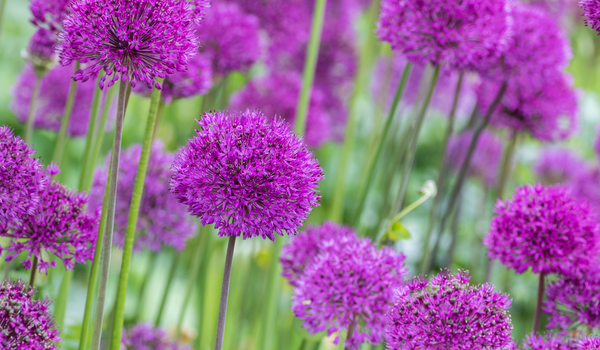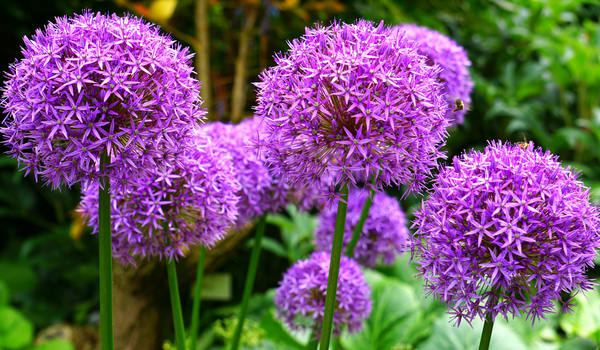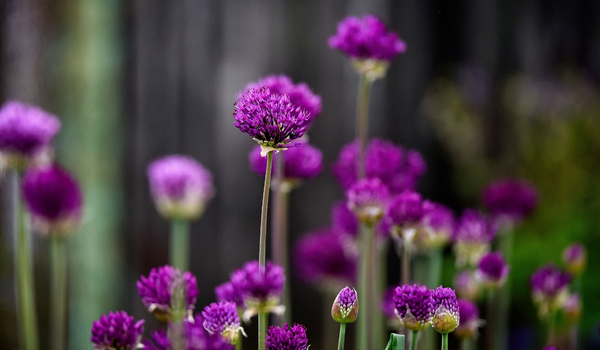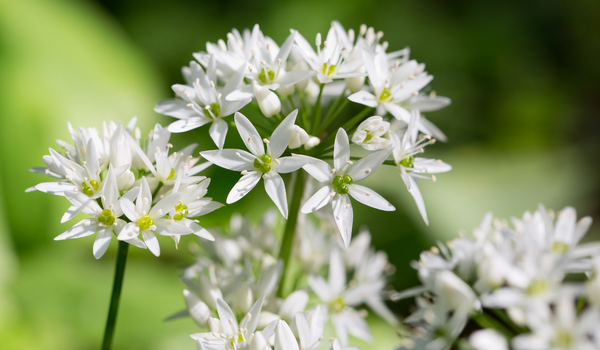How to plant Alliums? - The ultimate planting guide for Alliums
Alliums are known for their ball-shaped flowers and ability to grow very tall on their long, sturdy stems. They are very charming flowers and eyecatchers in any garden. They come in different sizes and colors, but the most popular is the well-known purple Allium. In this ultimate planting guide for Alliums, we’ll tell you all the things you must know about planting Allium bulbs.
How should Allium bulbs be planted?
Planting Allium bulbs can seem daunting at first. But no worries, whether you’re a seasoned gardener or a green thumb, the planting process is really easy. We’ll guide you through the process of planting Allium bulbs. If planted the correct way, you can enjoy a beautiful display of Alliums in Spring!

Optimal timing for planting Alliums in Fall
Planting Alliums is best done in the Fall, which is the optimal season for these magnificent flowering bulbs. As a part of the onion family, Alliums encompass a diverse range of species, including popular varieties like Allium Giganteum and Allium Globemaster. The cool soil temperatures during Autumn allow the bulbs to establish strong root systems before the harsh winter sets in. By planting them at the right time, typically from September to November, you ensure a splendid spring display of vibrant, spherical blooms atop tall, sturdy stems. Remember to select a well-draining location with ample sunlight to witness these stunning flowers flourish in your garden.
Should Allium bulbs be soaked before planting?
When planting Allium bulbs, soaking them before planting is generally not necessary. Alliums are resilient and adaptable plants that thrive in a variety of soil conditions. Soaking bulbs might actually increase the risk of rotting, especially in heavy or poorly drained soils. Instead, it is recommended to plant Allium bulbs directly into well-draining soil at the appropriate depth and spacing, ensuring they receive ample sunlight. This will allow the bulbs to establish themselves naturally and promote healthy root development. If you want to enhance their growth, consider adding compost or organic matter to the soil before planting, which will provide essential nutrients for the bulbs to flourish.
Where to plant Alliums for maximum impact
When considering the best place to plant Alliums, choose a location with well-draining soil, receiving full sunlight for at least six hours daily. These flower bulbs thrive in areas that offer good air circulation, preventing potential issues caused by excess moisture. Alliums prefer slightly alkaline to neutral soil pH, ideally between 6.0 and 7.5, which ensures optimal nutrient uptake and growth. Avoid waterlogged or heavy clay soils, as they may lead to rot. For an enchanting garden display, select a spot where these beauties can complement taller perennials or shrubs, adding vertical interest and a burst of color to your landscape throughout their blooming season.
For tips on nurturing your bulbs after planting, check out our guide on how to grow alliums. For tips on maintaining your alliums after planting, check out our guide on how to care for alliums.

How deep to plant Allium bulbs
When planting Allium bulbs, it's generally recommended to plant them at a depth of 2 to 3 times the size of the bulb itself. This typically translates to around 4 to 6 inches deep in most garden soils. Planting at the appropriate depth ensures that the bulbs are well-protected and allows for optimal root development, resulting in healthy and vibrant Allium blooms in your garden.
Preparing soil for Alliums: creating the perfect growing environment
To create an ideal environment for vibrant Allium growth, start by selecting a well-draining site with full sun exposure. Loosen the soil to a depth of 8-10 inches, removing any weeds or debris. Incorporate organic matter such as compost or well-rotted manure to enhance soil structure and fertility. Aim for a slightly acidic to neutral pH range of 6.0 to 7.5. Adding a balanced granular fertilizer before planting can provide essential nutrients. Remember to space Allium bulbs appropriately to allow proper air circulation.
How many Allium bulbs to plant for impact
The number of Allium bulbs you should plant depends on factors like the bulb's variety, desired visual impact, and available space. Generally, larger varieties like Allium Giganteum may be planted around 6-8 inches apart, while smaller varieties like Allium moly can be planted a bit closer, around 3-4 inches apart. For a visually striking display, aim for at least 10-15 bulbs per square foot. Keep in mind that larger bulbs typically produce more substantial blooms.

What to do with Allium bulbs when they arrive
When your Allium bulbs arrive, ensure a successful start for these majestic blooms by following these steps.
- Choose a well-draining, sunny spot in your garden, as Alliums thrive in sunlight.
- Gently plant the bulbs at a depth of approximately three times the bulb's height, leaving enough space between each bulb to accommodate their growth.
- Remember to water them thoroughly after planting.
With their unique and captivating spherical blossoms, Alliums are a stunning addition to any garden.
Can I plant my Allium bulbs indoors?
While typically planted outdoors, it is possible for Alliums to thrive indoors. To successfully grow them indoors, use well-draining soil, provide ample sunlight or supplemental grow lights, and maintain a consistent watering routine. Remember, while indoor Alliums can flourish temporarily, they might not reach the same size or longevity as their outdoor counterparts.
Can you plant dried-out Allium bulbs?
Planting dried-out Allium bulbs can lead to disappointing results as their viability significantly decreases when they lose moisture. To ensure successful growth, it's recommended to use plump and firm bulbs for planting. Dried-out bulbs might struggle to establish roots and produce healthy shoots, impacting the overall vigor of the plant.
If you do have dried-out bulbs, it's advisable to attempt rehydration by placing them in damp peat moss or a moist environment before planting. However, prevention through proper storage and purchasing high-quality bulbs is the best approach.
Please don’t mistake dried-out bulbs for dormant bulbs. Dormant bulbs are not actively growing, but they are alive and capable of resuming growth when conditions become favorable. During dormancy, bulbs conserve energy and resources. This is a normal part of many plants' yearly cycle, allowing them to survive adverse conditions like cold weather. Planting dormant bulbs at the appropriate time ensures they will grow and produce healthy foliage and flowers when the growing season begins.

Can I grow Allium in pots?
Planting Allium bulbs in pots and containers is a versatile and space-saving way to bring the elegance of these stunning blooms to your patio, balcony, or small garden areas.
With these steps, you can enjoy the beauty of Alliums on your patio or balcony, making them a versatile choice for container gardening. When choosing a container, opt for one with good drainage to prevent waterlogging. Fill it with a well-draining potting mix enriched with organic matter. Plant your Allium bulbs at a depth of 3-4 times their diameter, typically 3-4 inches deep, and ensure they're spaced adequately to avoid crowding.
Place the pots in a sunny location as Alliums thrive in full sun. Regular watering is essential, but avoid overwatering, as these bulbs dislike sitting in waterlogged soil. Fertilize with a balanced liquid fertilizer during the growing season.
Pots vs. ground
Allium bulbs thrive in both pots and the ground, offering versatile planting options for garden enthusiasts. When cultivated in pots, they flourish as stunning container plants, making them ideal for balconies, patios, or small garden spaces. Ensure well-draining soil in the pot to prevent waterlogging, as these bulbs dislike soggy conditions. On the other hand, planting Allium bulbs directly in the ground presents an opportunity for larger clusters and a more natural appearance in garden beds. Regardless of your choice, provide adequate sunlight and proper soil conditions, and your Alliums will reward you with their enchanting, globe-like blooms in spring and early summer.
How many Allium bulbs can I plant in a container?
The number of Allium bulbs you can plant in a container depends on the container's size and the specific Allium species you're cultivating. In general, for smaller varieties like Allium 'Purple Sensation', you can comfortably plant around 5 to 7 bulbs in a 10-inch diameter container. For larger species such as Allium 'Globemaster' or 'Gladiator,' it's advisable to use a larger container, like 18 inches in diameter, and plant 3 to 5 bulbs. Remember to leave enough space between bulbs to ensure proper air circulation, usually about 4 to 6 inches apart, and provide well-draining soil to prevent waterlogging. Regularly water and fertilize your container Alliums for vibrant, eye-catching blooms.
Looking to add these stunning blooms to your garden? Browse our wide selection of allium bulbs for sale.
Share
